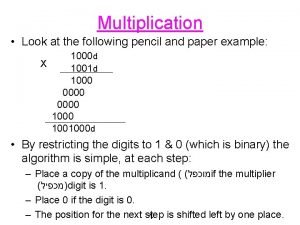Find a Seat Get out your pencil pen














- Slides: 14

Find a Seat • Get out your pencil (pen if you must) & Paper • Get a Calculator If you need one • Find the Mean, Median and Mode of each of the following data Sets 1. 1, 1, 2, 5, 6, 9, 10 1 2. 1, 2, 10, 9, 5, 6, 1 2 3. 1, 2, 3, 4, 10, 10 3 4. 7, 4, 5, 6, 9 4 Mean Median Mode

Use Measures of Central Tendency and Dispersion Goal: Compare mean, median, mode, range and mean absolute deviation. MM 1 D 3 a MM 1 D 4

Vocabulary • mean: the average of a numerical set. x • median: The middle number in a numerical set when the values are written in numerical order. • mode: the value(#) that occurs most frequently • measure of dispersion: describes the distribution or spread of the data. (range) • range: the difference between the greatest value and the smallest value.

Deviation from the mean: the difference of a data value and the mean of a set of data. x–x MAD • Mean absolute deviation: the average deviation from the mean (the average of how far each data is from the mean)

Your Notes MAD-calculate the mean absolute deviation for the set of numbers 5, 5, 6, 7, 12, 13 Step 1: Calculate the mean of the data set. x-x Step 2: Find the absolute values of the differences of each data point and the mean.

Step 3: Find the sum of the absolute values. Step 4: Divide the sum by the total number of values in the data set. This means that all the data is on average about ____ units from the mean of ___.

Example 2 The top 4 finishing times (in seconds) for two different teams in the 50 meter dash are given. Compare the spread of the data for the two sets using (a) the range and (b) the mean absolute deviation. Team A: 5. 8, 6. 0, 6. 2, 6. 4 Team B: 5. 7, 5. 9, 6. 5, 6. 7 Solution: a) Team A: Team B: The range for Team ____ is greater than the range for Team ___, so the data for Team ____ covers a wider interval than the date for Team ____.

Step 1: Calculate the mean of the data set. Step 2: Find the absolute values of the differences of each data point and the mean. Step 3: Find the sum of the absolute values. Step 4: Divide the sum by the total number of values in the data set. b) The mean for Team A is _____, so the mean absolute deviation is:

Step 1: Calculate the mean of the data set. Step 2: Find the absolute values of the differences of each data point and the mean. Step 3: Find the sum of the absolute values. Step 4: Divide the sum by the total number of values in the data set. b) The mean for Team B is _____, so the mean absolute deviation is:

Team A Mean 6. 1 Team B 6. 2 MAD 0. 2 0. 4 The mean absolute deviation for Team ____ is greater, so the average variation from the mean is greater for the data for Team ____ than for the data for Team _____.

Checkpoint 2. In Example 2, suppose the slowest time for Team B was 6. 6 seconds. Recalculate the range and mean absolute deviation. Team B: 5. 7, 5. 9, 6. 5, 6. 6 Range: _______ Step 1 Mean: _______ Step 2 Step 3 Step 4

Box Method for MAD Step 2 Sum: Count: Data 5. 7 5. 9 6. 5 6. 6 Mean: Step 1 Deviation from Mean | | = Sum: Count: Mean Absolute Deviation: Step 4 Step 3

Step 1: Calculate the mean of the data set. Step 2: Find the absolute values of the differences of each data point and the mean. Step 3: Find the sum of the absolute values. Step 4: Divide the sum by the total number of values in the data set.

Find the Range and the mean absolute deviation of the following data sets: Be sure to copy the data set to your paper 1. 2. 3. 4. 5. 6. 10, 7, 13, 10, 8 110, 114, 108, 106 87, 75, 85, 77, 74, 82 15, 17, 21, 17, 15, 23 40, 46, 41, 46, 49, 46, 44 50. 8, 51. 6, 51. 9, 52. 5, 52. 8, 53. 1
 Get out get out get out of my head one direction
Get out get out get out of my head one direction Get on get off get into get out of
Get on get off get into get out of Haw haw de karabaw vs kutsilyo de almasen
Haw haw de karabaw vs kutsilyo de almasen Pen grasp vs modified pen grasp
Pen grasp vs modified pen grasp Pen pencil ruler rubber
Pen pencil ruler rubber Paper and pencil algorithm multiplication
Paper and pencil algorithm multiplication Pen and pencil quiz
Pen and pencil quiz Find out the odd one out
Find out the odd one out What __________ you _________ last weekend?
What __________ you _________ last weekend? You put your right foot in
You put your right foot in Please sit down and your seat belts
Please sit down and your seat belts Please sit down and your seat belts
Please sit down and your seat belts Sit in your assigned seat
Sit in your assigned seat Sit in your assigned seat
Sit in your assigned seat Sit in your assigned seat
Sit in your assigned seat


























